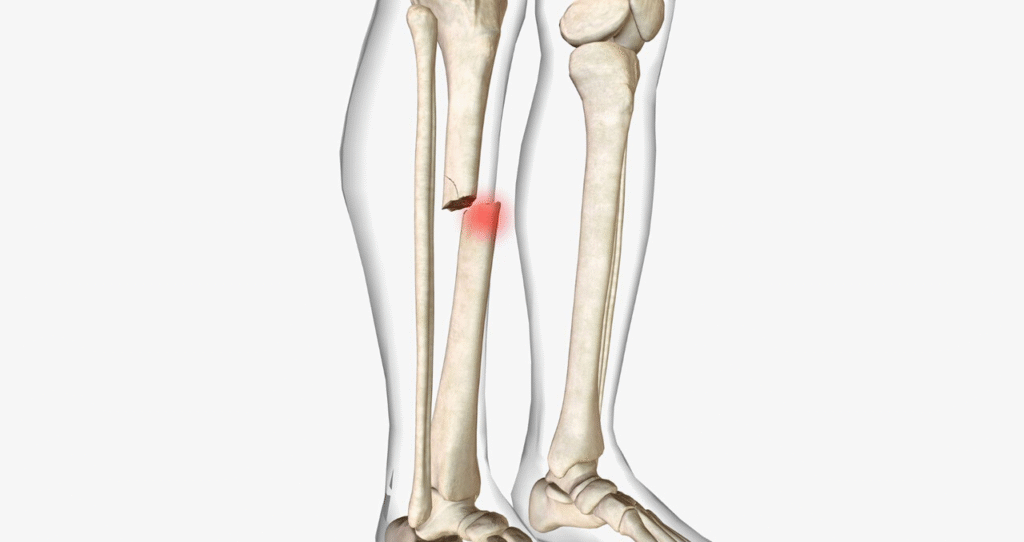A tibia fracture, also known as a shinbone fracture, is one of the most common long-bone injuries in the body. Since the tibia supports much of your weight during standing, walking, and running, a fracture can drastically limit mobility and demand prompt medical attention. In many cases, especially those caused by car accidents, sports injuries, or severe falls, emergency care is essential to prevent complications and begin immediate stabilization. Understanding tibia bone fractures helps you recognize symptoms early, seek the right treatment, and ensure a safe, effective recovery.
What Is a Tibia Bone Fracture?
The tibia, or shinbone, is the larger of the two bones in the lower leg and runs from the knee to the ankle. It plays a crucial role in weight-bearing and stability, making it essential for everyday activities like walking and running. A tibia fracture occurs when the bone cracks or breaks due to high-impact trauma or repetitive stress.
Fractures can range from small hairline cracks to complete breaks that cause the bone to shift out of place. Depending on the severity and location of the fracture, near the knee, along the shaft, or near the ankle, treatment and recovery will vary.
Symptoms of a Tibia Bone Fracture
Recognizing the symptoms of a tibia fracture early ensures prompt treatment and prevents complications. Common signs include:
- Severe pain: Intense pain in the shin, especially when putting weight on the leg.
- Swelling and bruising: Rapid swelling and visible discoloration around the injury site.
- Deformity: In severe fractures, the leg may look misshapen or out of alignment.
- Inability to bear weight: Difficulty or inability to stand or walk on the affected leg.
- Open wound or exposed bone: In open fractures, the bone may break through the skin, requiring immediate emergency care.
Causes of a Tibia Bone Fracture
Tibia fractures can result from many different events, but high-impact trauma is the most common cause. Factors include:
- Sports injuries: Contact sports like football or basketball and high-impact activities like skiing often lead to tibia fractures.
- Falls: Landing directly on the leg or twisting it awkwardly during a fall can cause breaks.
- Car accidents: High-speed collisions frequently cause severe tibia fractures, often combined with other leg injuries.
- Repetitive stress: Long-distance running or repetitive impact can lead to stress fractures, especially if bone strength is compromised.
- Osteoporosis or weakened bones: Individuals with reduced bone density are more prone to fractures even from minor falls.
Types of Tibia Bone Fractures
Tibia fractures are classified based on their pattern, location, and severity:
- Transverse fracture: A straight horizontal break across the bone.
- Oblique fracture: An angled break caused by twisting or diagonal force.
- Spiral fracture: A break spiraling around the bone, usually from rotational forces.
- Comminuted fracture: The bone shatters into multiple pieces due to severe impact.
- Stress fracture: Small cracks caused by repetitive stress or overuse.
- Open (compound) fracture: The bone pierces through the skin, increasing infection risk.
- Closed fracture: The bone breaks, but skin remains intact.
How Tibia Fractures Are Diagnosed
Accurate diagnosis is vital for proper treatment and healing. Healthcare providers use the following methods:
- Physical examination: The doctor checks for swelling, deformity, tenderness, and mobility. They may assess circulation and nerve function in the lower leg and foot.
- Medical history: Understanding how the injury occurred helps determine the type of fracture and potential associated injuries.
- Imaging tests:
- X-rays to identify the fracture pattern and alignment.
- CT scans for complex fractures or joint involvement.
- MRI scans to detect soft tissue injuries or stress fractures not visible on X-rays.
- X-rays to identify the fracture pattern and alignment.
Treatment Options for Tibia Bone Fractures
Treatment depends on the fracture type, location, and severity:
Non-Surgical Treatment
- Casting or splinting: Used for stable fractures; immobilizes the leg to allow natural healing.
- Functional bracing: Allows limited movement while maintaining bone alignment.
- Physical therapy: Begins after immobilization to restore strength and flexibility.
Surgical Treatment
- Intramedullary nailing: A metal rod is inserted into the bone’s canal to stabilize it.
- Plates and screws: Used for fractures near joints or with multiple fragments.
- External fixation: Pins and frames outside the body stabilize severe or open fractures.
Pain management, antibiotics (for open fractures), and close follow-up are also part of comprehensive care.
Recovery Time for Tibia Bone Fractures
Healing times vary depending on the fracture’s complexity and the patient’s health:
- Minor/stress fractures: 6–8 weeks with rest and protective bracing.
- Moderate fractures: 3–4 months, often requiring physical therapy.
- Severe fractures (surgical cases): 6 months or longer, especially if accompanied by soft tissue damage.
Factors like age, nutrition, and compliance with rehabilitation exercises can influence recovery. Athletes may require additional time before returning to high-impact activities.
Get 24/7 Emergency Care at Neighbors Emergency Center
If you suspect a tibia fracture, especially if there is severe pain, visible deformity, or exposed bone, seek immediate medical attention. Neighbors Emergency Center is open 24/7, providing rapid diagnosis with on-site imaging and expert treatment to prevent complications and ensure proper healing. Don’t delay care; prompt treatment helps you recover faster and avoid long-term mobility issues.

